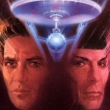 Today is the second Friday in June and the number one movie at the American box office is a Star Trek movie. And on the second Friday in June of 1989 another Trek film opened, Star Trek V: The Final Frontier, to an entirely different reception. This weekend TrekMovie begins a 20th anniversary look back at STV with a series of articles, starting with this (repost of our 2008) retro review.
Today is the second Friday in June and the number one movie at the American box office is a Star Trek movie. And on the second Friday in June of 1989 another Trek film opened, Star Trek V: The Final Frontier, to an entirely different reception. This weekend TrekMovie begins a 20th anniversary look back at STV with a series of articles, starting with this (repost of our 2008) retro review.
Review: Star Trek V: The Final Frontier
By Bill Kowinksi
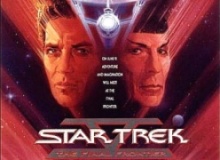
In the movie Little Big Man, the elderly Cheyenne medicine man called Old Lodge Skins decides it’s time for him to die. He goes to the top of the mountain, performs his rituals, reclines on the ground and closes his eyes. For a few moments nothing happens, except for some distant thunder. Then a raindrop falls on his face, startling him into opening his eyes. He stands up and prepares to go back home. “Sometimes the magic works,” he explains, “and sometimes it doesn’t.”
Every original cast Star Trek movie made missteps and experienced chaos on its way to the screen. Coming off their biggest success in Star Trek IV: The Voyage Home, the Star Trek movie team was confident. They’d successfully added humor to the mix, and it seemed they knew just how to make the magic, in spite of any obstacle. But this time it didn’t quite work.
In hindsight, it’s possible to see ways in which the stars did not align this time. Beginning serious work on the script and the filming was delayed, by among other things, something familiar from today: a Writers Guild strike. The delay would put the film in competition with several blockbusters, including Indiana Jones and the Last Crusade, Dead Poets Society, Ghostbusters II, and Batman. These would become important to the moviemaking process as well as the box office, because they kept the usual visual effects houses busy—especially Industrial Light and Magic. Trek would have to look elsewhere, with near- disastrous results. A Teamsters strike also hampered location shooting.

Star Trek V’s June 9 release sandwiched between four top 10 movies
After initial rave reviews, Star Trek V: The Final Frontier came under critical fire and had less than stellar box office. Theatre owners in that very competitive summer of 1989 shortened the run to make way for the next blockbuster. Today among Trek fans this is the least popular of the original cast movies. When it was next in line for a special edition DVD, director William Shatner begged Paramount to fix visual effects problems with today’s CGI magic, especially in the last part of the film, even promising to foot half the bill himself. Paramount refused.
Everyone who has seen this movie (and some who haven’t) know what they don’t like about it. The visual effects are clearly a problem. Not only are they especially inadequate at a couple of key moments, but in some relatively routine scenes—the Enterprise shuttle in flight, for instance—the effects are obviously unfinished, lacking the subtle details and shading that makes them look dimensional and “real.” These are perhaps more damaging, because they take viewers out of the world of the movie, and can shake their confidence in the moviemakers.
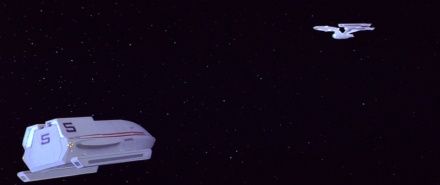
Not the finest moment in Star Trek Movie effects
Then there’s the story: Sybok, a charismatic Vulcan renegade, captures the Enterprise to take him to the fabled planet beyond the Great Barrier at the center of the galaxy to meet God. In interviews and their books, the actors, producers etc. involved in this film attribute its problems to the movie’s premise. (Gene Roddenberry had tried a similar exploration in his first script for the first Star Trek movie, called “The God Thing,” but the studio rejected it.)
Almost alone, William Shatner (who came up with the story) disagrees: he believes the problem was that he compromised on his core ideas, and robbed the film of it’s dramatic energy. In various ways, they’re probably all right.
On the one hand, dealing with such a subject in any meaningful or even credible way in a big studio feature film would be very hard to do. Plus anything touching upon religious beliefs is going to offend some part of the audience. That was true then (when Shatner was inspired, or provoked, by the phenomenon of popular tele-evangelists then saturating TV screens) and it is even truer now, when Star Trek fans—especially on the Internet– seem split according to their political and religious loyalties and orientation, and any reference to religion brings charges of prejudice and worse.
On the other hand, going in search of God and finding the Devil is a repeated sci-fi premise but if done well, it is often relevant to contemporary times—especially, as in this case, when the seeker (Sybok) confident in his righteousness, ends up face to face with the devil in himself. But compromises and continued tweaking which left their residues in the final script probably did rob the movie of some internal coherence.
There are smaller issues that some find particularly irksome: the introduction of Sybok as Spock’s long-lost half brother, the humor at the apparent expense of some regular characters (especially Scotty) the suggestion of a Scotty-Uhura romance, etc. All these may be remnants of the original story that had the Enterprise crew, including Spock and McCoy, side with Sybok against Kirk— Shatner’s tone-deaf proposal, even if it was more dramatic. Both Leonard Nimoy and DeForest Kelley insisted their characters couldn’t betray Kirk, and so they didn’t.
The elements for a successful movie were there in “The Final Frontier”: action, visual sweep, drama, character moment, important issues of contemporary life, plus the humor that worked within the story of “The Voyage Home.” But due in part to various missteps and in part to the story development, it can be argued that in the first part of the movie, for all its flashiness and memorable scenes of action and camaraderie, and for all the provocative ideas given physical form, the narrative didn’t engage our emotions and involvement with a strong sense of why we should care about what happens.
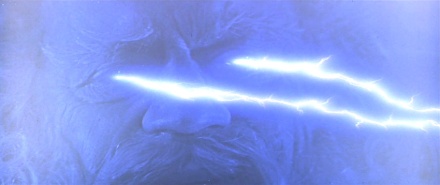
STV went in search for God but found trouble
Viewing and Re-viewing
I saw this movie in a theatre when it opened, and I’ve seen it on TV, on tape and several times on DVD. A film’s flaws are acute at first because of disappointment that it isn’t better than it might have been. But after all this time, a movie on DVD is what it is, and its flaws become part of its nature. Most importantly, this is one of only six movies with the whole original cast, and there aren’t going to be any more. It’s worth honoring what’s good about it and what’s good in it.
Probably my biggest surprise on re-viewing it was noticing the visual sense director William Shatner brought to it. He used extreme outdoor settings to give some visual dimension in those pre-CGI days, but where he excells is in moving the camera inside the Enterprise and other enclosures, and especially in framing small groups of characters– the kind of elegant two and three shots that became the visual signature of the original series.
Shatner had to overcome Dee Kelley’s resistance to doing the of McCoy at his father’s bedside, struggling with his duty as a doctor to preserve life against his duty as a son to end suffering and preserve his father’s dignity. But now this is perhaps Kelley’s most dramatic scene in any of the films.
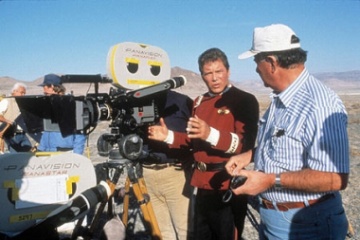
William Shatner directs a scene in uniform on Star Trek V: The Final Frontier
While some humorous scenes are questionable, others are classic moments that reveal the crew’s camaraderie. (The screenplay is by David Loughery, who Shatner credits with much of the humor.) They range from brief gags (Kirk saying wistfully that he misses his old command chair, followed by Spock’s tilting his head in sympathy; Scotty bursting through the brig wall shouting, “Dinna you know a jailbreak when you see one!”) to longer scenes, such as the brig scene itself. And while the early scene of Kirk, Spock and McCoy around the campfire has its awkwardness, it also has moments of convincing informality unmatched elsewhere in Star Trek. The reprise of this scene at the end is one of the most intimate moments involving the Trek trinity—and one of the great gifts we’ll always have from these movies.
Even some of the more eccentric elements (Kirk’s mountain climbing and Spock’s jet-pack, Uhura’s dance) are now unforgettable elements in the Trek legend.
There are other considerable virtues: the quality of the acting (especially Laurence Luckinbill’s brilliant performance as Sybok), and a film score that is considered one of Jerry Goldsmith’s best, for example. But I would also argue that the last part of the film—including the part that Shatner called “horrendous”—constitutes solid, meaningful and provocative storytelling in the best Trek movie tradition. To explain what I mean, we go back to the movie’s theme.
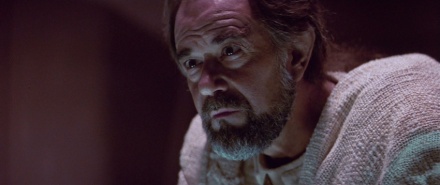
Luckinbill’s Sybok feels your pain
The God Thing
From one point of view, Sybok fails as a character in this film because he is not simple enough: he is not clearly a powerful, malevolent villain. But because he is complex and human, his character succeeds in other ways.
Sybok is on the one hand a religious zealot, certain God has spoken to him, and called him to pierce the Great Barrier at the center of the galaxy and find the fabled Sha Ka Ree. (You might wonder what combination of mystical words from various religions were chosen to name this heavenly planet. The answer is a little more Hollywood than holy: it’s a play on “Sean Con-ner-y,” the movie god that Shatner hoped would play Sybok.)
On the one hand, Sybok is a Vulcan renegade, convinced that the path to ultimate knowledge is through emotion, not logic—a perennial Star Trek tension that Spock himself has explored.
On the other hand, Sybok seems to have an inexplicable (and at times unbelievable) power over people, but on the other hand, his psychological skills are pretty sophisticated. After Sybok extracts McCoy’s agony over his father in a kind of psychic holodeck, Sybok urges him to release his pain over it. "You have taken the first step. The rest we will take together." Counselor Troi would recognize the basic approach of exploring a person’s pain, and after its initial release and revelation, going into it more deeply.
When Spock says he has already acknowledged and dealt with the pain of his father’s rejection of his human side, he has attained the therapeutic goal, which is also the goal of other soul paths: self-knowledge.
Kirk provides yet another point of view. Sybok tells him that he’s seen essential elements of his close friends—“This is who they are. Didn’t you know that?” Kirk has to admit that he didn’t. But he refuses to go through the process to release his own pain. Sybok suggests he is afraid. “I’m afraid of nothing,” Kirk says (a line since repeated by Denny Crain.) Kirk wants to keep his pain, because its essential to who he is. As someone who has literally been split into the Good Kirk and Bad Kirk, he understands the mutual dependence of that duality within him.
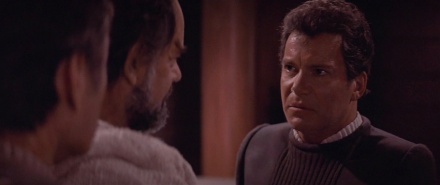
Kirk likes his pain
This scene, which takes place in the magnificent new observation lounge, ends as the Enterprise approaches the Great Barrier. Kirk warns Sybok that it’s never been breached. Sybok says that if we do it, will that convince you that my vision is true? It’s then he reveals it’s a vision from God “who waits for us on the other side.” “You’re mad!” Kirk exclaims. “Am I?” Sybok shows some doubt, and then recovers his sunny transcendence: “We’ll see.”
As a visual effect, The Great Barrier is pretty underwhelming. But immediately after it is breached, some of the best scenes in the movie begin. From the observation lounge, Kirk, Spock and McCoy see the planet Sha Ka Ree before them. “Are we dreaming?” McCoy asks. “If we are, then life IS a dream,” Kirk replies. The reference is to the campfire song they sang early in the movie (“Row, Row, Row Your Boat”) when Spock considered the lyrics and later announced, “Life is not a dream.”
Sybok returns control of the Enterprise to Kirk, knowing that he won’t leave without exploring the planet below. He accompanies the trinity aboard a shuttle. This sequence is the most magical in the movie: the dramatic quick cuts among the faces as they all wonder what they really will see, while bathed in the eerie violet light from the planet. They disembark in a strange landscape anxiously, sharp silhouettes against the alien haze. (All this was done with special effects at the site, rather than visual effects created in an effects house—a distinction I learned from a talk by Dan Curry.)
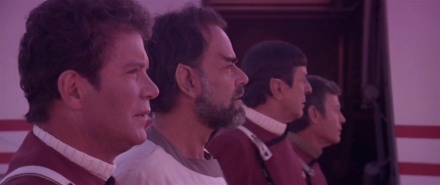
Kirk, Sybok, Spock and McCoy embark into the unknown
At first nothing happens. But soon some power builds walls of rock around them that might be a cathedral, or a prison. The power reveals itself as faces sacred to various religions, settling on one resembling familiar portraits of the Old Testament God. The voice flatters Sybok, but insists the Enterprise be brought closer, to transport him beyond the Barrier. Then Kirk utters his famous, very-Kirklike impudent question: “Excuse me, but what does God want with a starship?”
This is the very human challenge to those who claim higher authority: a question. This particular being answers by hurling a thunderbolt into Kirk’s chest, and then another into Spock when he repeats the question. Sybok is appalled, which is interesting, since the Old Testament God is often angry and smites wrongdoers. But it rattles Sybok’s faith, and he demands the being reveal itself. Which it does: with Sybok’s face, and its evil laugh.
Sybok immediately understands that he’s looking at his own shadow reflected by a powerful captive being—“my arrogance, my vanity,” and just as quickly, he sacrifices himself to save the others: his redemption.
Later, when McCoy and Spock are speculating on whether God could ever be found in the eternal reaches of outer space, Kirk replies: "Maybe he’s not out there. Maybe he’s in here—in the human heart." It’s a daring statement, though it comports with at least an aspect of many religions. And it is clearly a Star Trek statement.
But the full statement is also that if God is within the human heart, so is the Devil. There is a famous Cherokee story that relates to this: an elder tells his grandchildren that there are two wolves fighting inside everyone, one good and one bad. “Which one wins?” the children ask. The grandfather replies, “the one you feed.” That’s Star Trek’s view of the future in a nutshell.
The last part of the movie was supposed to have spectacular effects as the evil force pursues Kirk. They aren’t here, to Shatner’s anguish, but I for one don’t miss them. Maybe we could have seen more of Sybok’s struggle with the captive power, but Kirk’s escape passes quickly without damaging the story, because of his surprise rescue.

Sybok takes on ‘god’
I haven’t even mentioned two other elements of the story: the Federation, Romulan and Klingon representatives on the Planet of Galactic Peace—another failed Paradise—who Sybok kidnapped to lure the Enterprise, and the young punk Klingons who pursued the Enterprise beyond the Barrier. But the final scenes tie all the elements together in the best Trek storytelling tradition, with Kirk on the planet expecting to be killed by the decloaking Bird of Prey, but instead is rescued by it. The Klingon representative actually commits an act of galactic peace, and at a joint party later, Scotty exclaims, “I never thought I’d be drinking with a Klingon”—an unnoticed and unplanned preview of events in Star Trek VI. (The cultural combination also figures in another classic joke, when Kirk is about to embrace Spock in thanks for rescuing him, and Spock demurs: “Please, Captain, not in front of the Klingons.”)
The final scene back at Yosemite around a campfire, in probably the oldest setting for human interaction, reinforces the power that binds these three men together—the ones often called the trinity—which is expressed in camaraderie, but can also be described as love. They sing together, and this time Spock joins in, because in enacting journeys of the imagination, life is but a dream.
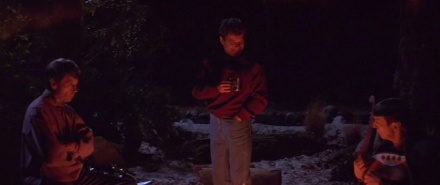
Trek’s core ‘trinity’ get back to basics
“The Final Frontier” certainly has its problems as a movie. Leonard Nimoy directed Star Trek III under tight supervision, and with a storyline that had to follow from the movie before. With the unique experience of directing a major feature film, he then made his Star Trek statement in “The Voyage Home.” William Shatner was given one film to learn from and to make his statement. Combined with some poor production decisions, this may have contributed to those problems.
But this movie should not be discarded or dismissed. It has classic moments, and there’s a classic Star Trek message somewhere within it. As the Enterprise approaches the mysterious planet, the camera fixes on the plaque at the base of the antique ship’s steering wheel in the observation lounge: “To boldly go where no man has gone before.” The search for a literal God outside becomes another exploration of dimensions of meaning and ultimate identity inside. In a different context, David Gerrold said it best: "Space is not the final frontier. The final frontier is the human soul."
More Star Trek V Anniversary Coverage
TrekMovie will be doing more coverage for the 20th anniversary of The Final Frontier over the weekend.
Bill Kowinski (aka Captain Future, William S. Kowinski) is an author and freelance writer living in Arcata, CA. Thanks to his Soul of Star Trek blog, he chaired a panel on that subject at the Trek 40th anniversary gala in Seattle last year. He’s been published in the New York Times, L.A. Times, San Francisco Chronicle and other international, national and regional publications, as well as Internet sites.
Images courtesy of Paramount Pictures, screencaps by TrekCore.com

You know something…I actually like this movie. It definitely has an original series episode feel to it…
I always like this film believe it or not, I was surprised so many people hated it.
actually it was 89, and I’m only putting that because someone else will and us trekkies do love to catch things like that. Usually you hear Trek being #5, but I guess that’s because they dont count it by total box gross.
I think number V was underrated in many ways.
Okay… so who’s in for a rousing rendition of “Row, Row, Row Your Boat”?
Anyone? Anyone? Anyone?
Bueller? Bueller? Bueller?
This movie is utter tripe from the opening credits to the final frame. You cannot simply pick out the few moments that “work” as if they are not part of a dreadfully ill-conceived whole. Compared to all other Trek those moments are in truth only the one’s that are least embarrassing. The Final Frontier should be considered essential non-viewing for any true fan of Trek, not to many all the ‘Shat needs to be in Star Trek’ again groupies.
I like it also. It does have its moments.
1989 you mean…
I hated Star Trek V after several viewings, it had potential, but the stars did not align for it. I had hoped Paramount let Bill Shatner re-work the SFX for a Director’s Cut Blu-Ray release, like they did for the late Robert Wise and his ST-TMP DVD release. With Trek XI still making big bucks at the cinema, Trek will be around for many more years to come. I do like Karl Urban’s McCoy and Simon Pegg’s Scotty, but DeForest Kelley and James Doohan will always exist in my imagination for as long as I live… The final frontier IS the human soul!
@linuxglobe at twitter.com
I don’t care what anybody says, this flick was light years better then Insurrection. My only problem with 5 is when the Klingon bird of prey kills God.
I still contend if they got Sean Connery to play Sybok (Shatner’s first choice) and had Shatner stuck to his guns for his story and the special effects were done right, this would’ve been one of the more popular Trek movies. The premise was good, searching for God and finding the Devil. Also, the actress that played the Romulan ambassador is a terrible actress, she ruined the whole movie for me.
Star Trek V has problems, but the scene on the Observation Deck is among the best Kirk, Spock & McCoy scenes in any of the movies. And lest we forget, this movie WAS #1 at the box office opening week. It just couldn’t stay there with all the competition.
While it is my least favorite of all 11 movies, it is still a good movie. It’s a lot better than a lot of the crap out there today. I think people tend to rate Star Trek movies only amongst other Trek movies, all in all this flick is pretty good.
This movie is true to TOS… some of the episodes (and movies) just weren’t that good.
like what Fry says in Futurama:
“you know, Star Trek? 79 episodes, about 30 good ones”
that said, i can watch this movie and enjoy it. but, i don’t watch very often.
This movie overall in every way was awful, but like you said since we only will ever have 6 of them, you have to try and take a few worthwhile nuggets that you can. Whoever approved this story really screwed up, and really shut down the great momentum they had going with 2,3 & 4. Shatner’s ego leads to the crew meeting god. It is a shame we could have gotten one or two more solid tos movies.
I still contend that with an effects overhaul and some artful editing, this film could work much better. Shatner even offered to work with Paramount, but they refused.
It will never be as good as TWK or ST09, but I’m okay with that.
I agree with Bill, there won’t be any other original cast movies, so why not make the best of what we have? Trek fans consititute enough market share to make it a profitable venture.
Either that, or some intrepid fan will do their own recut, with their own effects, it will be the most popular movie bootleg ever, with Paramount will be left out in the cold.
This review cements how I’ve felt about this movie for quite a long time. I think if for a few creative decisions and circumstances beyond Shatner’s control, this movie could’ve really worked. I also have to agree about McCoy’s “dad scene”. That is probably his single best bit of acting in all of Trek, it is extremely effective.
Anything that deals with God and/or religion falls on many deaf ears. Even Trekkies. I love STV because it’s the type of story Gene loved to tell.
My favorite line comes from Kirk. “Perhaps God is not out there.” and then he points to his chest and says “Perhaps he’s in here, the human heart.”
Just like Nemisis STV is worth a second, third and fourth look.
STV: The Great Trek Turd Of ’89—
The horror….The horror…The horror…The horror…The horror…The horror…The horror….The horror…
The lone pimple on the butt of an otherwise pretty good film series (the original movies).
I love how the retro review basically begins with a list of excuses! Lol. :)
This movie just stinks. Period.
And redressing the special effects wouldn’t make any difference to me. You can put a turd in a tuxedo…but it’s still a turd nonetheless.
I wanted to row, row, row my boat right out of the theater!!!
I appreciate the fair and balanced review. I enjoy the movie, flaws and all. It’s like an 80th episode of TOS!
As a fan in the theater Back in the Day, I never even noticed the “problems” with the visual effects. Honestly, when the writing is this bad, and the directing is this bad, I can’t be bothered to care about how expensive the FX look. Of course, I grew up on shows like Blake’s 7 and Doctor Who and Battlestar Galactica and Buck Rogers, so crappy FX are just automatically filtered into their story-role without any special effort … and by the same token, expensive and highly-polished FX don’t impress me (which may be a big part of the reason why I’m more reserved in my admiration for ST09 than many others around here … I’m just not all that swayed in either direction by FX, good or bad).
#12: “And lest we forget, this movie WAS #1 at the box office opening week. It just couldn’t stay there with all the competition.”
Sure, but the first week of box office never has much to do with the movie itself, only with the movie’s marketing and the public’s expectations and whatever else is out. It takes a week or three for word-of-mouth to become more important than the pre-release buzz.
After so much promise with ST IV… Maybe if the special effects weren’t so utterly insulting, or the Romulan princess wasn’t so utterly annoying, or the ending so utterly bad…
How come nobody ever mentions that great scene where Sybock gets a hair cut in the shuttle, on their way down to the planet.
You all must know what i’m talking about, it’s the best part of the movie.
Maybe in the next DVD they can CGI his hair back.
I read an interview with Laurence Luckinbill not long ago where he said Star Trek V was “one of the best” Star Trek movies ever done. Ha! Poor guy. :-) I do agree with what this review says, though – whether you like his character or not, he gave a great performance!
PARAMOUNT, PLEASE LET THE SHAT SORT THIS MESS OUT ONCE AND FOR ALL !!!!
It’s a lot of fun to watch, and there are a lot of good laughs, but sorry I don’t consider this one Cannon. Here’s what really happend:
Kirk decided after his trip to the 20th Century that he wanted to do a little “LDS” (LSD) that is. So after McCoy and Spock went to sleep at the camp site Kirk droped some acid and the result was the rest of the movie.
Seriously, Voyager gets trapped in the Delta Quadrent and they’re all like “Oh Crap, it’s going to take 70 years to get home” Maybe they should have been stranded in the DQ aboard the Enterprise A then they could have been home in time for dinner, around a campfire.
#23 … He cut his hair on the ship, before going down to the planet. People dress up for church, so if you’re going to meet God, why not?
When the notion of Sybok—Sarek’s child with a Vulcan “princess” and therefore Spock’s elder half-brother—was introduced into Star Trek canon, I wouldn’t be at all surprised if Dorothy Fontana threw up in her mouth a little.
One of the things which irked me most about the character of Sybok was the feeling that it diluted the impact of Spock’s breaking with Vulcan tradition (and that of his family), something which I felt was significant to the backstory of one of my favorite characters in television/movie history.
The visual effects should be remastered in ST:V. The studio cut the shooting schedule of this film, didn’t allow re/shoots of key scenes, and cut the overall budget by ten million dollars. They owe it to the fans and they very much owe a directors cut to Bill Shatner for short sheeting him in the first place. I’ve seen the fan edited version of this film with different visuals for just the opening credits and this small change made a huge impact on the flow of the film. So if some fan boy with a mac can make this much difference just imagine what someone with some real major resources could do. Dave Rossi are you out there?
#21—” I’m just not all that swayed in either direction by FX, good or bad.”
Agreed, although I think we might be of the last generation to see it that way.
Lackluster special effects do not, to this day, impede my enjoyment of TOS. I certainly could have overlooked the f/x problems if the story had been better.
Only Kirk could hit God with a Photon Torpedo!!
Better than Insurrection and Generations.
#29: “They owe it to the fans […]”
How? Why?
#25—“PARAMOUNT, PLEASE LET THE SHAT SORT THIS MESS OUT ONCE AND FOR ALL !!!!”
That’s a nice thought, but I don’t think we’ll be refunded anytime soon.
:)
19. Closettrekker
Don’t mince words bones, tell us what you really think.
#30: “I certainly could have overlooked the f/x problems if the story had been better.”
That’s pretty much the way I am with _any_ kind of nitpicking. If the movie sweeps me up, transports me, satisfies me … it can have all the nits in the world and I just can’t be bothered to notice them.
If I’m noticing nits, it’s because the movie isn’t holding my attention, and my mind is finding other ways to entertain itself.
Or, as I’ve said in the past: “If I don’t notice a nit until my fourth viewing … well, the fact that I’m on my fourth viewing really says it all.”
“I think we might be of the last generation to see it that way.”
Okay, now you’re just being a downer. :)
#31—“Better than Insurrection and Generations.”
It very well might be, but I was never interested enough in the prospect of a TNG movie to even bother paying to see one—so there were no built-in expectations on my part. They could have handed the script of ‘Ishtar’ to the TNG cast. I still couldn’t have been that disappointed.
Has anyone heard the commentary for the movie? Most of the time, it veers off and they aren’t even talking about the movie. The little text commentary for the DVD does the same thing
SHATNER SHOULD BE SHOT FOR THIS FIASCO
I remember seeing this on opening day in an almost empty theatre.
Another factor to the film’s box-office failure which is interesting to note is that while TWOK & TSFS were both successful Summer releases, TVH, with its lighter humor-based plot was moved to a Winter holiday release where it did better than either of the other two Summer films, having little other similar competition.
While the competition in the post houses with other vfx-driven films impacted the effects, the films themselves definitely had an impact at the box office. Opening against the huge hits of Batman, The Last Crusade, Lethal Weapon 2. Honey I Shrunk The Kids, Dead Poets Society, etc. it’s hard to imagine what Paramount was thinking. Obviously TVH was moved got a Winter release because it was a softer film, so even though they demanded a similar treatment for TFF and the previous Summer releases performed more poorly, the still elected to move it back to a Summer slot? Not that it would have done much better that Winter against Back To The Future II, Driving Miss Daisy and The Little Mermaid, but I’ll bet it would have done much better then the Summer. Afterall, Paramount knew what they had before they set the schedule and ST:V really lacked the stuff Summer movies were clearly offering.
In many ways I felt about Trek the way I felt about Insurrection and in some respects Nemesis. Trek movies are at their best when they are onboard the ship, strategizing and fighting the enemy. The action in TFF, INS, & NEM feels artificially induced – people too old really to be mounting ground assaults. It feels unrealistic and forced. Outside of that, at least TFF & INS offered very little in the way of more traditional action. TVH was indeed a fluke, but as a light-hearted WInter film it offered the same beloved elements which makes Trouble With Tribbles the classic it has become, though bereft of the elements which otherwise comprise the best of the episodes. Indeed TFF would have done much better with those audiences, despite its obvious story and vfx flaws which Bill Kowinski fairly reviews.
I’ve always enjoyed STV. Lots of nice cinematic moments. Mr. Luckinbill should have got an Oscar nomination. The good stuff considerably outweighs the bad.
#35
Poor visuals do detract from a films enjoyment. When you purchase a copy of a film and the visuals in the damn menu are better than whats in the feature film then yes there is a problem. You can’t expect Bill Shatner or any director to have schedules shortened and budgets cut and still make some parts of a film work. The original script was superior to what was up on the screen. Poor production quality is what we as fans and the movie going public ended up with, and yes Paramount owes us something better than what was finally presented.
Bill,
Please accept my thanks and gratitude for this touching review of my favorite Star Trek movie. I think you captured its esse and did so in a way that harkens to the Star Trek loved by an important minority of Trekkers. Indeed, the fraternity amongst the principals is something most of us will never know. I am fortunate to have such friends as those Shatner shared with us and yes, the campfire is the sine qua non of such camaraderie. I suppose it is possible those fans who are dismissive or even contemptuous of this film have never experienced this in their lives – a pity, really, as it is a fundamental part of our spiritual life, Christian or otherwise.)
As to the film’s religious content, I am delighted Shatner chose to show us universal religious truths, elegant and graceful and powerful, rather than indulge the cheap and sneering condescension toward people of faith popular since the 1970s.
In short, when I watch Star Trek V, I see elements of my own life’s experience and I am reminded that it is possible to see little snatches of heaven on earth, in between battles with Satan the old trickster himself.
Sincerely,
C.S. Lewis
For the valiant effort to rationalize this movie as something other than the abysmal effort that it was, ultimately this movie plays better as a DVD release on TV than it ever did as a movie.
And that may be the most telling indictment of Trek V.
This film opened up with splashes of delightfully Trek absurdity – Kirk’s mountain climb, Spock’s rescue…Goldsmith’s score was rousing, too. Ultimately, however, the core of the movie is doomed because its premise is fatally flawed.
Absolutely terrible special effects combined with some odd production choices just exacerbate the problems with this film. Shatner did have some good directorial moments, as the author of the article above noted, but they’re not sufficient to make the film even passable.
#21, it also finished #25 at the box office for the year, in the same company as The Abyss, Pet Cemetery, Black Rain, Major League, Always, Bill & Ted’s Excellent Adventures and License To Kill, most of which closed below. All things considered, it did respectably opening against such stiff Summer competition, however bad anyone thinks it was.
Well done! Great article.
One item left out, was Kirk’s attestation in Trek V: that he always knew that when its his time to die, he’d die alone…and he did…alone… on that metal bridge on Veridian III…on it…he paused a brief moment before he lept across the chasm to retrieve Soran’s remote…considering this his last selfless act to save an entire planet…
This film gets easily lost amongst the great TWOK, my personal fave TSFS and 2nd fave TUC; but I agree with Mr Kowinski’s summary of its necessity in our hearts as a solid piece of Trek lore.
My personal favorite’s include the fact that this is the ONLY TOS film to not feature the fanfare at the beginning…nice touch. I loved the Goldsmith score during the rock climb…my friend played it at his wedding during the guest’s seating. I liked the bookends of the troika camping out! Loved the assault phaser’s debut! Stylish, and blue beams reminiscent of TOS! I loved the scene where Kirk is confronted by Sybok after the failed assault! Its backlit similar to the Admiral’s intro in TWOK!
This score def stands up as a testament to Goldsmith!!! Simply outstanding! Although my friends and I thought it odd that they chose the ‘next gen’ theme to open the latest Trek feature! We were hoping for a a return to Horner’s fanfare, or a new one!
I recall walking in the theater on opening night! I had an interview for college the next day! And guy in full Starfleet uniform said to us “…Shatner directed it!!!” when we asked how it was! Ugh! We all felt a bit nervous! I think we all liked it, never really noticed the awful FX at that time, but we all agreed TVH was better!
I always liked this film as well as all of the others.
#35—“That’s pretty much the way I am with _any_ kind of nitpicking. If the movie sweeps me up, transports me, satisfies me … it can have all the nits in the world and I just can’t be bothered to notice them.”
I’m a little bit different. To touch again on a subject in another thread, I noticed plenty of “nits” to pick in all the Trek movies. Even as much as I love TWOK, I still found plenty of weakness in it back in the 80’s. Some of the more silly story premises are just part of the history of Star Trek movies. It’s just that, most of the time, they don’t overwhelm the story for me or preclude my ability to enjoy the film. Regarding the 7 films which feature all of the original characters, STV is the only one in which this is a problem for me.
Nitpicking, at least in this context, means finding minor flaws that might be construed as negative about something and criticising them. With STV:TGTTO89, it’s nearly the opposite of nitpicking to me. There simply aren’t many things which I don’t find negative about it—-Kelley’s acting being one of those scarce moments in the film which (to his credit) briefly caused me to forget that just about everything up to that point had been so disappointing.
Even an entire handful of “nits” in a one and a half to two hour film isn’t damning to me. But when the “nits” outnumber what is good or even good/neutral—-the “nits” have become an infestation!!!
I liked it the first time I saw it. The second time I saw the flaws. Emotion the first time-reason the second time; so very human. I still enjoy some of the humor (like finally getting to see a toilet on a starship!)
But the premise? As a student of earth ( and alien) religions, I know of none that believe their Deity resides on an Edenic world,
Scientifically, there is no Great Barrier at the center of our galaxy-only a Black Hole, or so it is believed at this point.
It did have potential, and perhaps had Mr. Shatner (no, I am not a fan) been able to fulfill his vision, he might not have turned out to be an arrogant, overweight ass. No, he still would have been arrogant but perhaps not an over weight ass!
We will never know, will we?
I’ve watched star trek v many many times . V.fond of it I like his movie, its performances, the story, dialog and never thought the fx were bad.